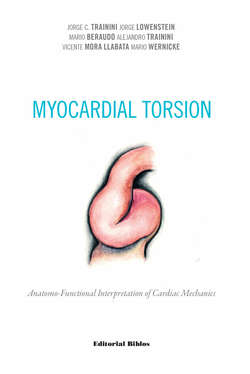Читать книгу Myocardial Torsion - Jorge C. Trainini - Страница 6
Prologue
ОглавлениеProbably only because of my age, I have had the fortune of making the leading prologue for a dozen books, generally of disciples and friends. It has always been an inspiring and personal pleasure rather than an obligation, a diversion in which one tries to give the future readers a global and necessary synoptic view of its virtues. I have to acknowledge that the work of making a prologue for the book of Professor Jorge Trainini et al.: Myocardial Torsion has been different from others, simply because this book is unique, unusual, and I dare say with admiration, it is a curious book, partly magical, full of personality, for initiatory readers, revealing, provocative, challenging, as a book about the knights of the Round Table presenting the reasons and pathways followed searching and perhaps finding the Holy Grail.
The book by Professor Jorge Trainini bonds with one of the most beautiful, romantic and for a long time misunderstood stories of the world of cardiology of the last hundred years: the life and work of Francisco Torrent Guasp (1931-2005), which would deserve in itself a film or better the production of a great opera, as was the life of the master, with its scientific zeals, its sufferings, its incomprehensible pathways, and an end that, unexpected and strangely striking, would be unbelievable in real life, as we would only see it as the exaggeration of the writer, passionate admirer of the hero.
Added to the attraction of a book with these characteristics is the unusual prose of professor Trainini, leader of this work. The book has the infrequent peculiarity of being based, to a great extent, on original personal and multidisciplinary investigations led by Professor Trainini, granting it an important extra value.
The text deals essentially with the anatomy and dynamic function of the heart clarified by the revolutionary anatomical studies of Torrent Guasp who, with his famous dissections, described how the ventricular myocardium was formed by muscle fibers which twisted unto themselves like a rope and flattened laterally as a band, shaped a helix that limited the two ventricular chambers defining their function. All his studies converged in the great outstanding and revolutionary contribution of diastolic suction as an active process due to the contraction of the myocardial band ascending segment.
The authors define their purpose since the first pages of the book: to provide solidity, validity and even more to the master’s concepts. The book attempts to answer a series of questions on cardiac physiology, which emerge when this is approached with the same anatomy of Torrent Guasp, and which are its essence: Do the bands surrounding the ventricles have a point of support similar to most muscles or are they supported by blood itself? How is ventricular torsion produced? Cardiac torsion implies friction mechanisms: is there an organic lubricating source? What is the relationship between ventricular vortex and myocardial torsion mechanisms? How is the mechanically active early diastolic ventricular suction explained? To answer these questions, among others, means fitting together many of the separate pieces that provide even greater strength to Torrents Guasp’s anatomy.
The book is originally organized into four chapters. In chapter 1 the authors write throughout nine sections, one of the most wonderful and original descriptions of myocardial functional anatomy that one could have possibly read. I wish to highlight, because I think it is especially interesting and surprisingly new, the concept of the cardiac fulcrum. The master Torrent Guasp considered that the cardiac band lacked a fixed point of support as the muscles in the musculoskeletal system, and which is the basis for their ability to develop force. The authors describe the structure of the origin and end of the myocardial band, which they call cardiac fulcrum in a parallelism and tribute to the concept of point of support to provide leverage expressed by Archimedes of Syracuse. It is amazing that in the first quarter of the 21st century they show us for the first time the existence of this structure with proper anatomical and histological entity, even more amazing in animal dissections. It is like finding an unknown island not represented in current maps. Only for this, one should be recreated and surprised in reading this book.
In chapter 2 the authors elegantly demonstrate, with 3D mapping electrophysiological studies of cardiac activation in human hearts, the propagation of the electrical stimulus in Torrent Guasp’s myocardial band, surpassing the theoretical ideas of the master.
In chapter 3, they express the theoretical and historical considerations of the cardiac suction pump, with a general vision obtained through the experimental models they developed to confirm the hypothesis.
Finally, in chapter 4 the book ends with a global synthesis of the complex cardiac functional mechanics dominated by the explanation of cardiac suction, the cornerstone of the master´s theory. This section stands out by the beautiful and difficult synthesis of cardiac torsion with myocardial strain echocardiographic techniques, for which the authors show exquisite proficiency.
This is certainly a different book in its structure, content and elaboration. It is a text that the reader may admire or criticize, that may create skepticism or surprise at the new data it proposes, but which undoubtedly will leave nobody indifferent, and that is something few books can achieve… My congratulations.
Madrid, 2019
Prof. Miguel Ángel García Fernández
Professor of Medicine-Cardiac Imaging
School of Medicine, Department of Medicine
Universidad Complutense de Madrid, Spain
